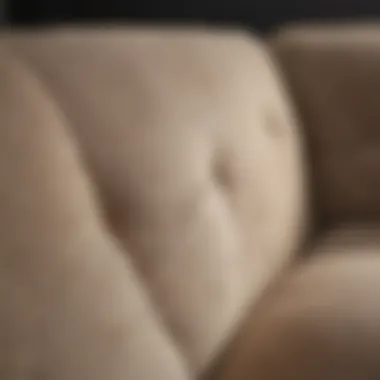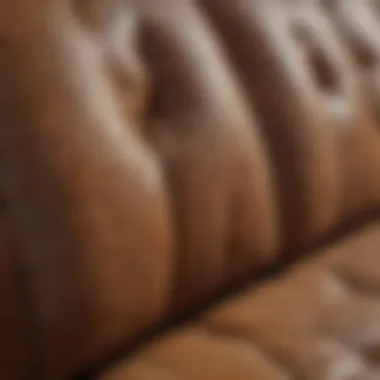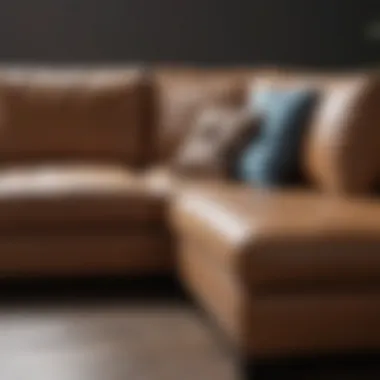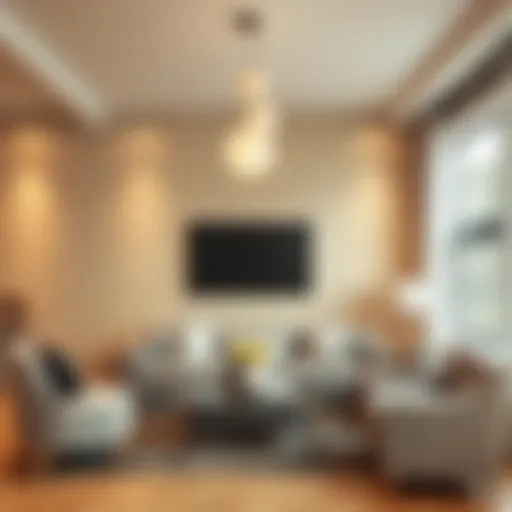Effective Strategies for Removing Water Stains from Your Couch


Intro
Water stains on your couch can be an eyesore, a silent testament to mishaps that often happen in our hustle and bustle lives. These stains may not just spoil the aesthetics of your living room but could also become a persistent reminder of spills and accidents. Before you toss a well-loved couch aside or look into expensive professional cleaning, there are numerous effective strategies to alleviate the situation. Understanding the factors that lead to these marks, along with tailored cleaning techniques suitable for various upholstery types, can help homeowners restore their furniture to its former glory.
Relevance is paramount here, especially when considering how integral couches are to our living spaces. They aren’t merely pieces of furniture; they are the heart of our homes where families gather, friends converse, and memories unfold. Every stain and mark has a story, and rather than covering it up, it's beneficial to learn how to confront it head-on.
In this article, we will explore essential insights regarding the causes of water stains, identify the diverse types of couch fabrics, and delve into practical strategies for effective cleaning. By arming yourself with knowledge, you can enhance both the longevity and beauty of your furniture, making your living space a delightful retreat.
Key Insights and Trends
Understanding Water Stains
Water marks can arise from various incidents: an accidental drink spill, a curious pet's mishap, or simply a damp cloth used for cleaning. Each situation leaves its characteristic mark, and knowing this can guide your cleaning approach.
The key to successful stain removal often lies in acting quickly. The longer a stain sits, the more stubborn it can become, potentially even leading to mold if not addressed promptly.
"Time is of the essence — the quicker you tackle a water stain, the easier it will be to eliminate it."
Current Trends in Upholstery Maintenance
Today, homeowners are gravitating towards more sustainable and easy-to-clean materials. Fabrics like performance velvet and acrylic blends are gaining popularity for their durability and stain resistance while remaining stylish and inviting. These materials can often withstand harsher cleaning methods without showing wear. Thus, investing in high-quality fabrics from the get-go can save a world of trouble in the long run.
Practical Tips and How-To Guides
Cleaning stains effectively requires an understanding of both the type of upholstery and the nature of the stain. Here’s how to navigate these waters:
Step-by-Step Cleaning Methodology
- Identify the Fabric Type: Check the care tag on your couch. This will inform you about the cleaning method you can use.
- Initial Blotting: Start by gently blotting the stain with a clean, damp cloth — don’t rub, as this can worsen the issue.
- Choose the Right Cleaner:
- Test in an Inconspicuous Area: Before applying any cleaner, always conduct a spot test on a hidden part of the couch to avoid any unexpected fallout.
- Apply the Cleaner: Dampen a cloth with your cleaning solution and dab it onto the stain. Wipe gently but thoroughly, then let it air dry.
- For water-soluble stains (such as from juices or coffee), mix one cup of water with one tablespoon of white vinegar or mild dish soap.
- For more stubborn stains, consider a store-bought upholstery cleaner that’s safe for your fabric type.
Preventive Measures
- Regular Maintenance: Vacuuming the couch regularly will help prevent dirt from settling into the fibers, minimizing the chances of staining.
- Implementing Coasters: For high-traffic and high-spill areas, using coasters can alleviate accidents.
- Protective Sprays: Consider applying a fabric protector to ward off stains in the first place.
Fostering a clean and vibrant living space isn’t just about cleaning; it’s about maintaining that sanctuary where daily life happens. Armed with the right knowledge and techniques, tackling water stains on your couch can transform your living environment, setting the stage for a comfy and stylish home.
Understanding Water Stains on Upholstery
Water stains on upholstery can be a real thorn in the side for homeowners and renters alike. These unsightly blemishes not only detract from the aesthetic appeal of your living space but also signal potential underlying issues if not addressed promptly. Knowing how to deal with these stains is vital, as it preserves the integrity and longevity of your couch. This section delves into the different dimensions of water stains, arming you with the understanding needed to tackle this problem head-on.
The Science Behind Water Stains
When we talk about water stains, we're not just referring to mere surface level discolorations; there’s a science tucked neatly behind these marks. Essentially, when water comes into contact with upholstery, it affects the fibers, pulling them apart and changing their natural state. This alteration causes light to reflect differently off the fabric, resulting in a visible mark.
Additionally, the minerals in the water itself, like calcium and magnesium, can leave behind residue that blends with dirt and grime, making the stains even more pronounced. Understanding this process is essential because it lays the groundwork for selecting the appropriate cleaning method, tailored to the type of fabric you’re dealing with.
Typical Causes of Water Damage
Water damage doesn't just come from spills during a party (though we all know how those go); there are several common culprits to be aware of:
- Accidental spills from beverages or food.
- Pet accidents, which can include urine or spilled water.
- Humidity and condensation, especially in areas with poor ventilation.
- Cleaning mishaps, where too much water is used during a cleaning session.
- Leaking containers, such as potted plants that may leave water stains if they drip on the couch.
Recognizing the source helps in not just removing stains but in preventing future occurrences, which is a win-win situation.
Recognizing Different Types of Stains


Not all water stains are created equal. They can vary greatly based on their origin, and identifying what you’re dealing with makes a world of difference. Here are some common types:
- Clear water stains, typically from clean water spills. These are often easier to remove.
- Brown or yellow stains, usually a sign of contaminants in the water, such as food residue or pet stains, which require more intensive cleaning techniques.
- Mold or mildew stains, often resulting from moisture left unchecked; these can pose health risks and should be dealt with swiftly.
By understanding these types, you can tailor your approach accordingly, saving both time and effort. In sum, being well-versed in the nature, causes, and varieties of water stains ensures you’re better equipped to act decisively when they rear their ugly heads.
Assessing the Material of Your Couch
Assessing the material of your couch is a critical step in dealing with water stains effectively. Each type of upholstery has its unique characteristics and required care techniques. Knowing the fabric not only helps in choosing the right cleaning method but also protects the integrity of your couch. For example, using a harsh cleaner on a delicate fabric like silk can lead to more damage than the stains themselves. Therefore, understanding your couch's material can save you both time and effort.
Identifying Upholstery Fabric
Before rushing to grab any cleaning solution, take a moment to identify the upholstery fabric. Common couch materials include cotton, polyester, leather, and microfiber, each with varied responses to stains.
- Cotton: Typically durable, cotton can often withstand a good wash but can absorb stains quickly.
- Polyester: This fabric is known for its stain resistance. Generally wipes clean well but should still be treated carefully.
- Leather: A classy choice prone to water stains. It demands special care because it can crack and lose its luster if treated poorly.
- Microfiber: This is a favorite for many due to its soft texture and ease of cleaning, but like others, it needs specific solutions to avoid damage.
You can check the manufacturer's label for specifics about your couch. Understanding the material will guide you on how to treat the stains.
Understanding Proprietary Cleaning Codes
Many sofas come with a label noting proprietary cleaning codes, and this is a golden ticket for anyone battling water stains. These codes usually represent different cleaning methods recommended for the fabric and can steer you clear of potential mishaps.
- W: Means water-based cleaners can be safely used. Consider this a green light for soap-and-water solutions.
- S: Indicates that only solvent cleaners should be used. Water is a no-go here, meaning you should avoid soaking the fabric if you care about its longevity.
- WS: A mixed bag; both water and solvent cleaners are permissible, giving you options based on what you have in your pantry or cleaning cabinet.
- X: This one gives a warning against any moisture, requiring professional cleaning.
Knowing these codes allows a more tailored approach to treatment, ensuring better results and protection against further damage.
"A stitch in time saves nine; knowing your couch's fabric and care instructions is like giving it the best chance to weather the storm of stains."
By properly assessing the material of your couch, you not only maximize the cleaning potential but also prolong the life of your beloved furniture.
Preparation for Cleaning
Before diving into the cleaning process, preparation is key—it’s like laying a solid foundation for a house. The right tools and mindset can make all the difference in obtaining satisfactory results when tackling those pesky water stains on your couch. Whether you're a seasoned home-maintainer or a newbie, careful preparation can assure you not only clean upholstery but also maintain your peace of mind throughout the chore.
Gathering Necessary Supplies
It’s time to roll up your sleeves and gather what you need! Here’s a handy checklist to get you started:
- Microfiber Cloths: Soft and absorbent, these are ideal for blotting and reducing the risk of scratches.
- Sponge: A gentle sponge can help with larger areas and give more control than a cloth.
- Mild Dish Soap: This is a gentle yet effective cleaning agent when mixed with water; avoid harsh chemicals that might damage the fabric.
- Vinegar: An all-purpose favorite, it can cut through stains and neutralize odors, but do exercise caution, especially with delicate fabrics.
- Baking Soda: This can lift stains and eliminate odors, acting as a mild abrasive when necessary.
- Soft-Bristle Brush: Great for scrubbing without potentially ruining the fabric.
- Lint Roller: Highly effective for picking up crumbs or hair that may interfere with your cleaning efforts.
Having these supplies within arm’s reach ensures you won’t be running back and forth, which could lead to extra frustration and potential mess. Making sure every item is suitable for your couch's material is also part of the preparation phase; it’s a small detail that can save you a huge headache later.
Testing Cleaning Solutions
Letting loose with cleaning products without knowing how they’ll react with your upholstery can feel a bit like playing with fire—not too wise, right? Testing your cleaning solution in a discreet area can prevent any unwanted surprises. Here's a simple method to ensure you won't be left with unexpected results:
- Pick a Hidden Spot: Ideally, find a corner or a spot that isn’t easily visible. This could be behind a cushion.
- Apply the Solution: Dampen a cloth with the cleaning solution, whether it’s soap and water or vinegar with a sprinkle of baking soda.
- Blot Gently: Don't scrub. Instead, blot the area to see how your couch reacts.
- Wait and Observe: Give it a few minutes. If there’s discoloration or any adverse reaction, rinse the spot with clean water and gently blot—then, reconsider the solution you intended to use.
"A little precaution goes a long way. Testing your cleaning method beforehand is like peeking under the hood before a long drive—wise and worth every effort."
This methodical approach saves time and heartache, ensuring your cleaning day doesn’t turn into a disaster. Remember, it’s not just about removing stains; it’s about preserving the life of your couch for as long as possible!
Cleaning Methods for Water Stains
Water stains on upholstery can be a thorn in the side of any homeowner or renter. Getting rid of them not only improves the aesthetic of your living space but also retains the value of your furniture. This section offers a variety of cleaning methods tailored to effectively tackle water stains, ensuring you have the most suitable options at your disposal. It’s crucial to recognize that the techniques you choose can depend on the material of your couch and the nature of the stains. Hence, let’s explore these methods in depth.
Using Soap and Water Solutions


This age-old combination is often the first port of call when confronting water stains. Mild soap mixed with lukewarm water performs miracles, cutting through the grime without causing further damage to upholstery.
- What to Use: The recommended soaps are typically dishwashing liquid or gentle hand soap. It’s vital to avoid anything too harsh, as strong chemicals could ruin the fabric.
- Method: Start by mixing a few drops of soap in a bowl of water. Dampen a clean, soft cloth in your soapy solution, wring it out, and gently blot the stained area. It’s important to work from the outside of the stain towards the center to avoid spreading it.
After you achieve the desired effect, rinse the area with another clean cloth dampened in plain water. Don’t soak it though—just dampen it lightly. You want to keep the residue minimal! Then, let it air dry.
Applying Vinegar and Baking Soda
The duo of vinegar and baking soda is like the trusty sidekick every homeowner should know about. This method not only tackles stains but also fights odors.
- Vinegar acts as a natural deodorizer and stain remover, while baking soda works to lift any residual moisture.
- How to Use: First, sprinkle baking soda generously on the water stain and let it sit for about 15 minutes. Next, mix equal parts of distilled white vinegar and water in a spray bottle. Lightly spritz the stained area with this solution and wait for a fizzing reaction.
After about 10 minutes, blot the area with a clean cloth. This step is key. Rinse with a damp cloth afterward and let dry completely. This method not only refreshes the couch but also makes it look new again.
Utilizing Professional Cleaning Products
Sometimes, taking the DIY route isn’t enough, especially for stubborn or extensive stains. Professional cleaning products cater to specific fabrics and stains, providing a more targeted approach.
- Types of Products: Look for upholstery cleaners designed for your fabric type. Brands like Folex or Resolve are reputed for their efficacy in combatting water stains.
- Application: Before you plow ahead, always follow the instructions on the label. Test the product in an inconspicuous area first to ensure it won’t cause discoloration. When ready, direct the cleaner onto the stain, let it sit for a few minutes (as suggested), and then blot with a clean cloth.
Using professional products can save time and often yields better results, especially if you are dealing with stubborn stains that resist simpler solutions.
Employing Steam Cleaning Techniques
Lastly, if you’re looking for a method that doesn’t just clean but also sanitizes your couch, steam cleaning is an excellent route to take. This method utilizes the power of heat to penetrate fibers while simultaneously lifting stains.
- Why Steam?: Steam cleaning can remove dirt and debris while killing bacteria and allergens that might reside in your upholstery.
- The Process: Start by vacuuming your couch to remove any loose particles. Next, fill a steam cleaner with water, and allow it to heat up according to the manufacturer's instructions. Apply the steam in a sweeping motion over the stained area, keeping the nozzle a few inches away from the fabric.
After steaming, use a microfiber cloth to wipe away any loosened stain residue. Remember to allow ample drying time post-cleaning, as the moisture from the steam may linger.
Practicing caution is imperative. Always check fabric care tags and ensure your cleaning methods align with the recommended practices for your couch's upholstery.
Drying and Aftercare Process
When dealing with water stains on your couch, the drying and aftercare process becomes a crucial step that often gets overlooked. Proper drying not only prevents mold and mildew growth, but it also ensures that your cleaning efforts are not in vain. Water penetrating deep into the upholstery can lead to unpleasant odors and long-lasting damage. Thus, understanding effective drying techniques and the aftercare required is essential for maintaining the quality and lifespan of your furniture.
Ensure Proper Drying Techniques
First and foremost, employing the right drying methods can make all the difference. Whether your couch is leather, suede, or fabric, drying techniques may vary, but the goal remains the same: you want to extract as much moisture as possible while avoiding damage to the material.
- Ventilation is Key: Make use of fans or open windows to circulate air around your couch. Good airflow helps moisture evaporate faster.
- Blot, Don’t Rub: After cleaning, using a clean towel to blot the area can absorb the remaining dampness. Rubbing can work the moisture further into the fibers, causing more harm than good.
- Use a Hairdryer Sparingly: If you're in a hurry, a hairdryer set to low may help, but be cautious. Keep it at a distance to prevent heat damage.
- Natural Absorbents: Consider using items like baking soda or cornstarch on the damp area. They can absorb moisture as well as help neutralize odors. Just sprinkle them on, let sit for a few hours, and vacuum it off afterward.
Tip: Always make sure to check the care instructions specific to your upholstery material to avoid any risk of wearing down or scorching the fabric while drying.
Inspect for Residual Stains
After the drying process is complete, it’s time to take a close look for any residual stains. Sometimes water stains may not be completely eliminated after the cleaning and drying process, necessitating a second pass at treating the affected areas.
- Visual Inspection: Examine the couch at different angles. Natural light can be your best friend here, as it highlights imperfections that might be missed.
- Touch Test: Run your fingers lightly over the area in question. If it feels rougher or discolored, it may need further treatment.
- Check for Odors: A musty smell can indicate trapped moisture, which could lead to more water damage if not addressed promptly. Sometimes, a simple air out won't cut it; you might need to use a fabric-safe odor eliminator.
- Re-treat if Necessary: If stains persist, don’t hesitate to repeat the cleaning process, using the same or alternative methods to eliminate any stubborn marks.
Maintaining your couch in prime condition is all about attentive care. By ensuring proper drying and inspecting closely for stains, you can enhance both the longevity and beauty of your upholstery.
Preventive Measures
Protecting your couch from water stains should be a top priority, especially if you value your home aesthetics and comfort. Water stains can mar the beauty of even the most luxurious upholstery and can lead to permanent damage if not dealt with in a timely fashion. This section discusses how staying ahead of trouble is the best strategy, showcasing methods that every homeowner can easily implement.
Implementing Regular Maintenance


Regular upkeep might sound like a drag, but think of it as an insurance policy for your furniture. A little effort can go a long way in prolonging the life of your couch, making it look spick and span for years. Start by vacuuming your couch at least once a week. This helps remove dust and debris that can trap moisture and lead to stains.
Another important practice is to address spills immediately. If a drink spills or a child gets too enthusiastic with their juice, reach for a cloth right then and there. Blot, don’t wipe; this will suck the moisture without pushing the liquid deeper into fabric fibers.
Consider these five simple maintenance tips:
- Keep beverages at a distance from the couch during gatherings.
- Always use coasters or trays for liquids to prevent accidental spills.
- Rotate and fluff cushions regularly to ensure even wear.
- Avoid placing your couch near sources of moisture or humidity, like windows that are frequently opened for ventilation.
- Use fabric protection sprays designed for your upholstery type to create a barrier against stains.
By being proactive, you reduce the chances of stains sinking into your couch’s material, preserving its condition and charm.
Protective Products for Upholstery
In today's market, many effective protective products can guard against water stains, spilling mishaps, or even unexpected marks. One fundamental item is a fabric protector spray, designed specifically for upholstery. It works much like a rain jacket for your couch, creating a barrier against rogue liquids. When using such products, always follow the manufacturer’s instructions for the best results.
Additionally, furniture covers or throws can be a practical solution, especially in households with pets or energetic kids. Consider using washable covers that can easily protect your couch from daily wear and tear.
Don’t overlook the importance of researching and choosing appropriate products. Check labels and online reviews—some options might be made for specific materials, ensuring optimal results without unwanted damage.
"An ounce of prevention is worth a pound of cure."
Investing in protective products and practices can save you a heap of trouble down the road. These small costs in time and finance can bolster the longevity of your furniture, allowing you to enjoy your living space to the fullest.
When to Seek Professional Help
Navigating the issue of water stains on your couch can sometimes feel like trying to solve a Rubik's Cube blindfolded. While many stains might seem like a simple fix, knowing when to enlist the help of a professional is crucial. This section delves into the specific aspects that should guide your decision.
Identifying Severe Damage
The signs of severe damage shouldn’t be ignored; they can be as subtle as a whisper or as evident as a neon sign. If your couch shows signs of mold, warped frame, persistent discoloration, or uneven drying patterns, it might be time to pick up the phone.
When assessing your couch, look for:
- Mold Growth: If you see dark spots forming, it’s a sure sign of moisture trapped within the fabric. Mold not only damages the upholstery but can also cause health issues.
- Discoloration: A stain that continues to spread or darken despite your efforts often indicates an underlying problem that needs professional intervention.
- Odors: A musty smell lingering around your upholstery usually points to trapped moisture or potential bacterial growth.
- Fabric Texture Changes: If the fabric feels crunchy or different to the touch, it may be hard to salvage without expert care.
Recognizing these signs early can save you a headache later on. Taking prompt action can be the difference between a professional cleaning and a total replacement.
Choosing the Right Cleaning Service
When it comes to hiring a professional for couch cleaning, making the right choice can feel like shopping for apples in an orange orchard. Here’s a roadmap to help you navigate the decision:
- Research is Key: Start by scouring local reviews. Websites like Reddit and Facebook can provide insights from others who have faced similar challenges.
- Ask for Credentials: Ensure the service you choose has proper certifications. Look for professionals skilled in various upholstery cleaning methods; this speaks to their credibility and expertise.
- Get Quotes and Compare: Reach out to several cleaning services for quotes. Don’t just go for the cheapest option; consider the value of experience and tools they bring to the table.
- Inquire about Methodologies: Ask about their approach—do they use eco-friendly products? Are their methods safe for your specific upholstery type?
- Check for Guarantees: A reputable service often offers satisfaction guarantees. If stains remain after their efforts, you want the assurance that they will rectify the situation without additional costs.
By taking the time to find the right service, you can ensure your couch receives the best possible care. After all, investing in a proper clean can extend the life of your furniture and keep your living space looking its best.
The End
In the realm of home maintenance, dealing with water stains on upholstery certainly ranks high on the list of challenges for homeowners and renters alike. The insights provided throughout this article aim to not only address these pesky marks but also to foster an understanding of the broader implications of upholstery care.
Recap of Effective Strategies
Returning to the various effective strategies, it’s clear that removing water stains isn’t just about having the right cleaning product on hand. Here’s a quick recap to keep in mind:
- Assess the Material: Different fabrics require different approaches. Knowing the material of your couch can help you select an appropriate cleaning method.
- Preparation is Key: Gathering the right supplies and testing cleaning solutions before application can save you from potential mishaps. Doing this ensures that your beloved furniture isn’t further damaged during the cleaning process.
- Cleaning Methods: From soap and water solutions to more unique techniques involving vinegar and baking soda, knowing diverse methods expands your toolkit.
- Proper Drying Techniques: Always prioritize drying your couch post-cleaning. It prevents mold growth and keeps the fabric fresh.
- Preventive Measures: Regularly maintaining your upholstery with proper care protects from future stains.
Understanding these strategies equips you not just for present challenges but prepares you for any future spills.
Encouragement for Ongoing Care
Water stains might seem like an inevitable occurrence, especially in households with kids or pets. However, when battling these stains, let it remind you of the broader story of care and maintenance. Establishing a cleaning schedule can integrate the maintenance of your couch into your regular routines. Here are a few considerations:
- Create a Cleaning Schedule: Set a monthly or seasonal timeline where you clean your upholstery.
- Invest in Protective Covers: These can act as barriers against various types of spills, thus extending the life of your couch.
- Stay Educated: Keep yourself informed about the latest products and techniques to maintain and restore your couches as needed.
Water stains may feel like a relentless battle, but with these resources, a proactive mindset, and a bit of patience, you can turn it into a manageable task. Your couch is not merely a piece of furniture; it’s part of your home’s aesthetic, comfort, and history. Taking care of it properly ensures that it continues to serve you well for years to come.



